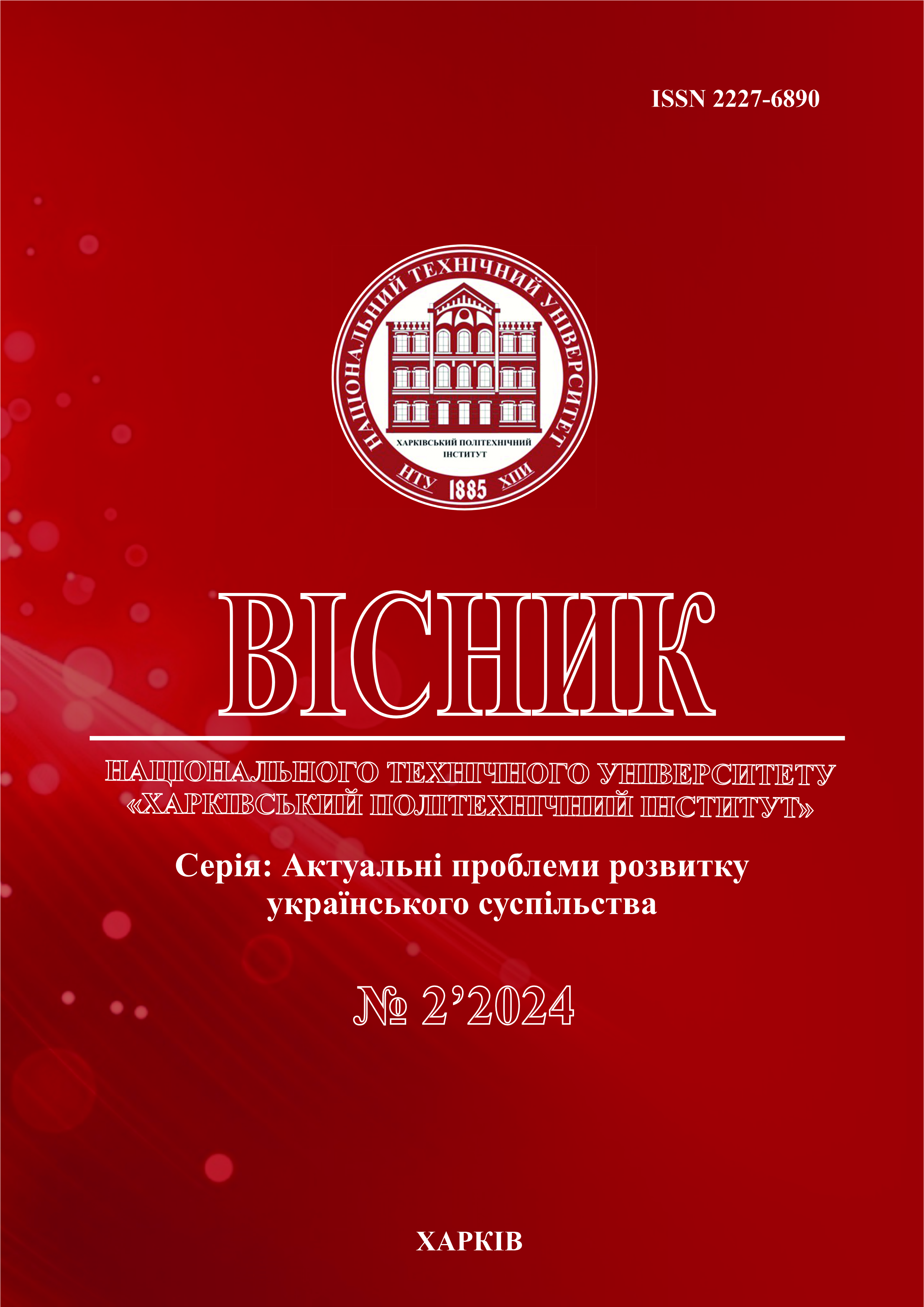ЗАЛУЧЕННЯ ГРОМАДЯН ДО ПУБЛІЧНОГО УПРАВЛІННЯ ЗАСОБАМИ ВІЗУАЛІЗАЦІЇ
DOI:
https://doi.org/10.20998/2227-6890.2024.2.14Ключові слова:
публічне управління, громадськість, політика, місцева влада, візуалізаціяАнотація
У статті вивчаються переваги використання різних технік візуалізації, що генеруються за допомогою програмного забезпечення, для залучення громадськості до процесу прийняття рішень, зокрема, й на місцевому рівні. Особливої уваги у цьому контексті набули питання розвитку та використання інструментів візуалізації для ефективної підтримки планування ландшафтів та ефективної інтеграції візуалізації у процес планування міського розвитку. Розглянуто методи моделювання, ГІС, соціальні мережі та автоматичний аналіз тексту як компоненти для формування потужної системи електронного урядування для полегшення участі громадськості в ньому.
Посилання
Zablotska-Siennikova N.V. (2019). Vizualizatsiia danykh v protsesi vysvitlennia diialnosti orhaniv publichnoi vlady. The experience of the past, the practice of the future II Proceedings of XXXXVIII International scientific-practical conference (April 6, 2019). Morrisville, Lulu Press. P. 148–151. Retrieved from http://hdl.handle.net/123456789/3879
Liashchenko L.A. (2002). Aktyvni miski heoinformatsiini resursy: klasyfikatsiia, vlastyvosti ta pryntsypy formuvannia. Inzhenerna heodeziia. Vyp. 48. S. 147–156.
Muliar V.P. (2020). Vizualizatsiia danykh ta infohrafika. Kharkiv : FOP Panov A.M. 200 s.
Panchenko H.O. (2023). Hromadska uchast yak mekhanizm realizatsii hromadskoho kontroliu v systemi publichnoho upravlinnia. Naukovi perspektyvy № 3 (33). S. 454–467. DOI http://doi.org/10.52058/2708-7530-2023-3(33)-454-467
Appleton K., Lovett A. (2003). GIS-based visualisation of rural landscapes: defining, Sufficient realism for environmental decision-making. Landscape and Urban Planning. № 65. Р. 117–131.
Blei, David M.; Ng, Andrew Y.; Jordan, Michael I. (January 2003). Lafferty, John. ed. "Latent Dirichlet allocation". Journal of Machine Learning Research 3 (4-5): pp. 993-1022. DOI: 10.1162/jmlr.2003.3.4-5.993
Cairo A. (2015). Graphics lies, misleading visuals. In New Challenges for Data Design, Bihanic D., (Ed.). Springer London, pp. 103–116.
Card S., Mackinlay J., Shneiderman B. (1999). Readings in Information Visualization: Using Vision to Think. San Francisco : Morgan Kaufman. 686 р.
Chadwick A. (2009). Web 2.0: New Challenges for the Study of E-Democracy in an Era of Informational Exuberance. I/S: A Journal of Law and Policy for the Information Society, 5 (1), Р. 9–41. Retrieved from http://moritzlaw.osu.edu/students/groups/is/files/2012/02/Chadwick_Formatted_FINAL.pdf
Coleman S., Moss G. (2012). Under construction: the field of online deliberation research. Journal of Information Technology & Politics 9, 1: 1–15.
Erik Glaas, Mattias Hjerpe, Martin Karlson and Tina-Simone Neset. (2020). Visualization for Citizen Participation: User Perceptions on a Mainstreamed Online Participatory Tool and Its Usefulness for Climate Change Planning. Sustainability, 12 (705); DOI: 10.3390/su12020705 Retrieved from www.mdpi.com/journal/sustainability
Friendly M. (Jan. 2008). A brief history of data visualization. In Handbook of Data Visualization, Springer Handbooks of Computational Statistics. Springer Berlin Heidelberg, pp. 15–56.
Friendly M. (Nov. 2008). The golden age of statistical graphics. Statistical Science 23, 4, 502–535.
Heer J., Card S.K., Landay J.A. (2005). Prefuse: a toolkit for interactive information visualization. in Proc. of SIGCHI (New York, NY, USA), pp. 421–430.
Jansen W. (Sept. 2009). Neurath, Arntz and ISOTYPE: The Legacy in Art, Design and Statistics. Journal of Design History 22, 3, 227–242.
Kosara R., Mackinlay J. (May 2013). Storytelling: the next step for visualization. Computer 46, 5, pp. 44–50.
Krum R. (2013). Cool infographics: effective communication with data visualization and design. John Wiley & Sons. 368 р.
Lange E. (1994). Integration of Computerized Visual Simulation and Visual Assessment in Environmental Planning. Landscape and Urban Planning. № 30. Р. 99–112.
Lange E., Schroth O. & Wissen U. (2003). Interaktive Landschaftsentwicklung. DISP. № 155. Р. 29–37.
Lengler R., Eppler J. (2007). Towards a Periodic Table of Visualization Methods for Management. In SM Alam, (Ed.), IASTED Proceedings of the Conference on Graphics and Visualization in Engineering. Acta Press: Clearwater, Florida, USA. Retrieved from http://www.visualliteracy.org/periodic_table/periodic_table.pdf
Macintosh A., Coleman S., Schneeberger A. (Jan. 2009). E-Participation: the research gaps. In Electronic Participation, Macintosh A., Tambouris E., (Eds.), Vol. 5694 of Lecture Notes in Computer Science. Springer Berlin Heidelberg, pp. 111.
Mayr E., Schreder G. (Feb. 2014). Isotype visualizations. A chance for participation & civic education. JeDEM – eJournal of eDemocracy and Open Government 6, 2, рр. 136–150.
Michels A., De Graaf L. (2010). Examining citizen participation: Local participatory policy making and democracy. Local Gov. Stud., 36, 477–491.
Parkin J.R., Sinclair A.J. (2014). Patterns of elitism within participatory environmental governance. Environ. Plan C Gov. Policy, 32, рр. 746–761.
Peter Sonntagbauer. (3-4 May 2012). FUPOL – a new approach to E-Governance: Combining Policy Simulation, GIS, Social Media and Open Government Data. CeDEM12 Proceedings of the International Conference for E-Democracy and Open Government. Danube University Krems, Austria. Р. 351–354.
Schiffer M. (2001). "Spatial Multimedia for Planning Support" in Planning Support Systems. Brail, R., Klosterman, R. (Eds.): Planning Support Systems: integrating geographic information systems, models and visualization tools. Redlands (ESRI Press). Р. 361–385.
Stenberg J., Abrahamsson H., Benesch H., Berg M. et al. (2013). Framtiden är Redan Här: Hur Invanare Kan Bli Medskapare i Stadens Utveckling [The Future Is Already Here: How Citizens Can Become Co-Creators of Urban Development]; Majornas Grafiska AB: Gothenburg, Sweden. Retrieved from https://research.chalmers.se/en/publication/174504
Stirling A. (2008). "Opening up" and "closing down". Power, participation, and pluralism in the social appraisal of technology. Sci. Technol. Hum. Values. 33, 262–294.
Silvana Tomic Rotim, Peter Sonntagbauer, Giorgio Prister. (2014). FUPOL: an Integrated Approach to Participative Policies. Interaction Design and Architecture(s) Journal IxD&A, 20, pp. 48-60. Retrieved from http://www.mifav.uniroma2.it/inevent/events/idea2010/doc/20_4.pdf
Tufte E.R. (1983). The visual display of quantitative information. Graphic Press, Cheshire, Conn., 189 р.
Visulands – Visualization Tools for Public Participation in the Management of Landscape: Change, Visulands Project, ETH Zürich, 2005. Retrieved from http://lrg.ethz. ch/visulands/ fs_visulands.html
Wang C., Burris M. (1994). Empowerment through Photo Novella: Portraits of Participation. Health Education Quarterly. № 21(2). Р. 171–186.
Wang C., Burris M., Xiang. Y. (1996). Chinese Women as Visual Anthropologists: A Participatory Approach to Reaching Policy Makers. Social Science and Medicine, № 42, 10. Р. 1391–1400.
Ware C. (2004). Information Visualization: Perception for Design. Amsterdam: Morgan Kaufmann. 486 р.

